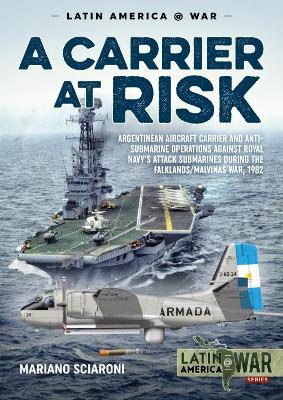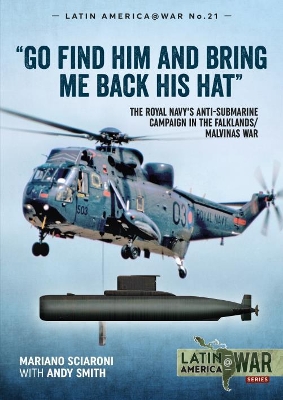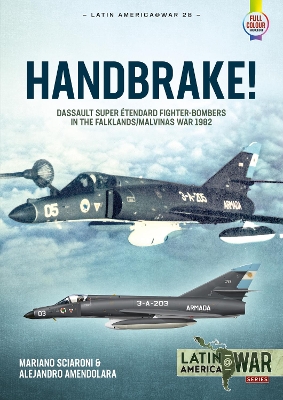Latin America@War
3 total works
The naval warfare of the last few decades appears dominated by operations of fast missile craft and a wide diversity of other minor vessels in so-called 'littoral warfare'. On the contrary, skills and knowledge about anti-submarine warfare on the high seas - a discipline that dominated much of the...Read more
The naval warfare of the last few decades appears dominated by operations of fast missile craft and a wide diversity of other minor vessels in so-called 'littoral warfare'. On the contrary, skills and knowledge about anti-submarine warfare on the high seas - a discipline that dominated much of the World War II, and once used to be the reason for existence of large fleets of the North Atlantic Treaty Organisation (NATO) and of the Warsaw Pact - appear nearly extinct. Indeed, it seems that no armed conflicts involving this form of naval warfare have been fought for a significant time.
As so often, the reality is entirely different. Submarine and anti-submarine warfare remain one of most sophisticated forms of armed conflicts to this day. Unsurprisingly, considering the amount of high-technology equipment necessary for their conduct, they are shrouded behind a thick veil of secrecy.
This is why the operations of the sole Argentinean aircraft carrier - ARA 25 de Mayo - during the much-publicised war in the South Atlantic of 1982 remain largely unknown until this very day. It is well-known that the United Kingdom deployed the largest task force its Royal Navy had assembled since the Korean War over 12,000 kilometres away from home. It is well-known that the operations of this task force proved decisive for the outcome of the war: it not only brought the air power that established itself in control of the air space over the battlefield, but also hauled all the troops and supplies necessary to recover the islands that were the core of the dispute. However, the impression created very early during this conflict - and largely maintained until today - is that ARA 25 de Mayo and other elements of the accompanying Task Force 79 of the Argentinean Navy were forced into a hurried withdrawal by the sheer presence of multiple nuclear attack submarines of the Royal Navy.
Based on years of research, including extensive investigation into naval operations of both sides of the conflict, 'A Carrier at Risk' is a vibrant and lucid account of a week-long cat-and-mouse game between anti-submarine warfare specialists on board ARA 25 de Mayo, and multiple nuclear attack submarines of the Royal Navy: an entirely unknown, yet crucial aspect of the South Atlantic War.
Illustrated by over 100 photographs, maps, and colour profiles, this volume closes one of the major gaps - though also a crucially important affair - in the coverage of this conflict.
As so often, the reality is entirely different. Submarine and anti-submarine warfare remain one of most sophisticated forms of armed conflicts to this day. Unsurprisingly, considering the amount of high-technology equipment necessary for their conduct, they are shrouded behind a thick veil of secrecy.
This is why the operations of the sole Argentinean aircraft carrier - ARA 25 de Mayo - during the much-publicised war in the South Atlantic of 1982 remain largely unknown until this very day. It is well-known that the United Kingdom deployed the largest task force its Royal Navy had assembled since the Korean War over 12,000 kilometres away from home. It is well-known that the operations of this task force proved decisive for the outcome of the war: it not only brought the air power that established itself in control of the air space over the battlefield, but also hauled all the troops and supplies necessary to recover the islands that were the core of the dispute. However, the impression created very early during this conflict - and largely maintained until today - is that ARA 25 de Mayo and other elements of the accompanying Task Force 79 of the Argentinean Navy were forced into a hurried withdrawal by the sheer presence of multiple nuclear attack submarines of the Royal Navy.
Based on years of research, including extensive investigation into naval operations of both sides of the conflict, 'A Carrier at Risk' is a vibrant and lucid account of a week-long cat-and-mouse game between anti-submarine warfare specialists on board ARA 25 de Mayo, and multiple nuclear attack submarines of the Royal Navy: an entirely unknown, yet crucial aspect of the South Atlantic War.
Illustrated by over 100 photographs, maps, and colour profiles, this volume closes one of the major gaps - though also a crucially important affair - in the coverage of this conflict.
"Go Find Him and Bring Me Back His Hat"
by Mariano Sciaroni and Andy Smith
Published 15 November 2020
When the Task Force of the Royal Navy started its southbound voyage, as the second major act during the Falklands/Malvinas War of 1982, its commanders assessed the Argentine submarines as the biggest threat. Even if limited in total size and scope, this threat was so conditioning that the conclusion...Read more
When the Task Force of the Royal Navy started its southbound voyage, as the second major act during the Falklands/Malvinas War of 1982, its commanders assessed the Argentine submarines as the biggest threat. Even if limited in total size and scope, this threat was so conditioning that the conclusion was that it had to be neutralised at the earliest possible moment in time, otherwise no victory would have been possible.
The British believed that the Argentines would wait for them in the waters of the war zone with two modern and dangerous German-made Type-209 submarines, and a modified US-made submarine from the times of the Second World War. To their good luck, this threat was quickly reduced to two, because during the first naval combat of the conflict, the old ARA Santa Fe was knocked out and captured by the Royal Navy at South Georgia.
Further anti-submarine operations followed on 1 May 1982, when ARA San Luis attacked Royal Navy warships, and, in turn, was counterattacked, resulting in scenes reminiscent of those from the movie Das Boot. Avoiding its pursuers, the boat distanced before re-attacking, a few days later - when multiple factors conspired to prevent it from becoming successful. Despite systematic pursuit by warships and helicopters of the Royal Navy, the submarine eventually returned to its home port in one piece.
Because the other Argentinean Type-209, ARA Salta, was non-operational, the withdrawal of the ARA San Luis also prompted the withdrawal of all the major units of the Argentine Navy into shallow waters off the coast of South America.
Although the undersea battlefield was thus actually empty of Argentine submarines, elements of the Royal Navy's task force continued detecting and tracking multiple sonar contacts over the following days and weeks. Indeed, they ultimately fired no fewer than 31 torpedoes, 49 depth-charges and 21 mortar salvoes at these.
POSSUB! Or Bring me back his Hat! is the story of the crews of 22 warships, submarines, anti-submarine-warfare helicopters, and Nimrod submarine-hunter aircraft, their intensive and advanced training, and combat experiences - a richly illustrated story that has never been told before.
The British believed that the Argentines would wait for them in the waters of the war zone with two modern and dangerous German-made Type-209 submarines, and a modified US-made submarine from the times of the Second World War. To their good luck, this threat was quickly reduced to two, because during the first naval combat of the conflict, the old ARA Santa Fe was knocked out and captured by the Royal Navy at South Georgia.
Further anti-submarine operations followed on 1 May 1982, when ARA San Luis attacked Royal Navy warships, and, in turn, was counterattacked, resulting in scenes reminiscent of those from the movie Das Boot. Avoiding its pursuers, the boat distanced before re-attacking, a few days later - when multiple factors conspired to prevent it from becoming successful. Despite systematic pursuit by warships and helicopters of the Royal Navy, the submarine eventually returned to its home port in one piece.
Because the other Argentinean Type-209, ARA Salta, was non-operational, the withdrawal of the ARA San Luis also prompted the withdrawal of all the major units of the Argentine Navy into shallow waters off the coast of South America.
Although the undersea battlefield was thus actually empty of Argentine submarines, elements of the Royal Navy's task force continued detecting and tracking multiple sonar contacts over the following days and weeks. Indeed, they ultimately fired no fewer than 31 torpedoes, 49 depth-charges and 21 mortar salvoes at these.
POSSUB! Or Bring me back his Hat! is the story of the crews of 22 warships, submarines, anti-submarine-warfare helicopters, and Nimrod submarine-hunter aircraft, their intensive and advanced training, and combat experiences - a richly illustrated story that has never been told before.


